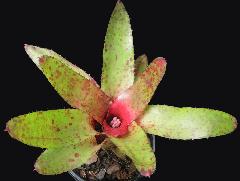
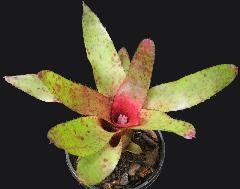
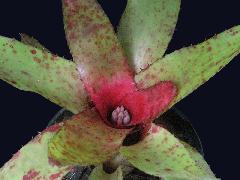
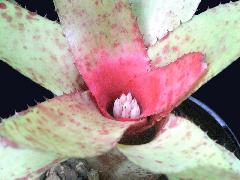
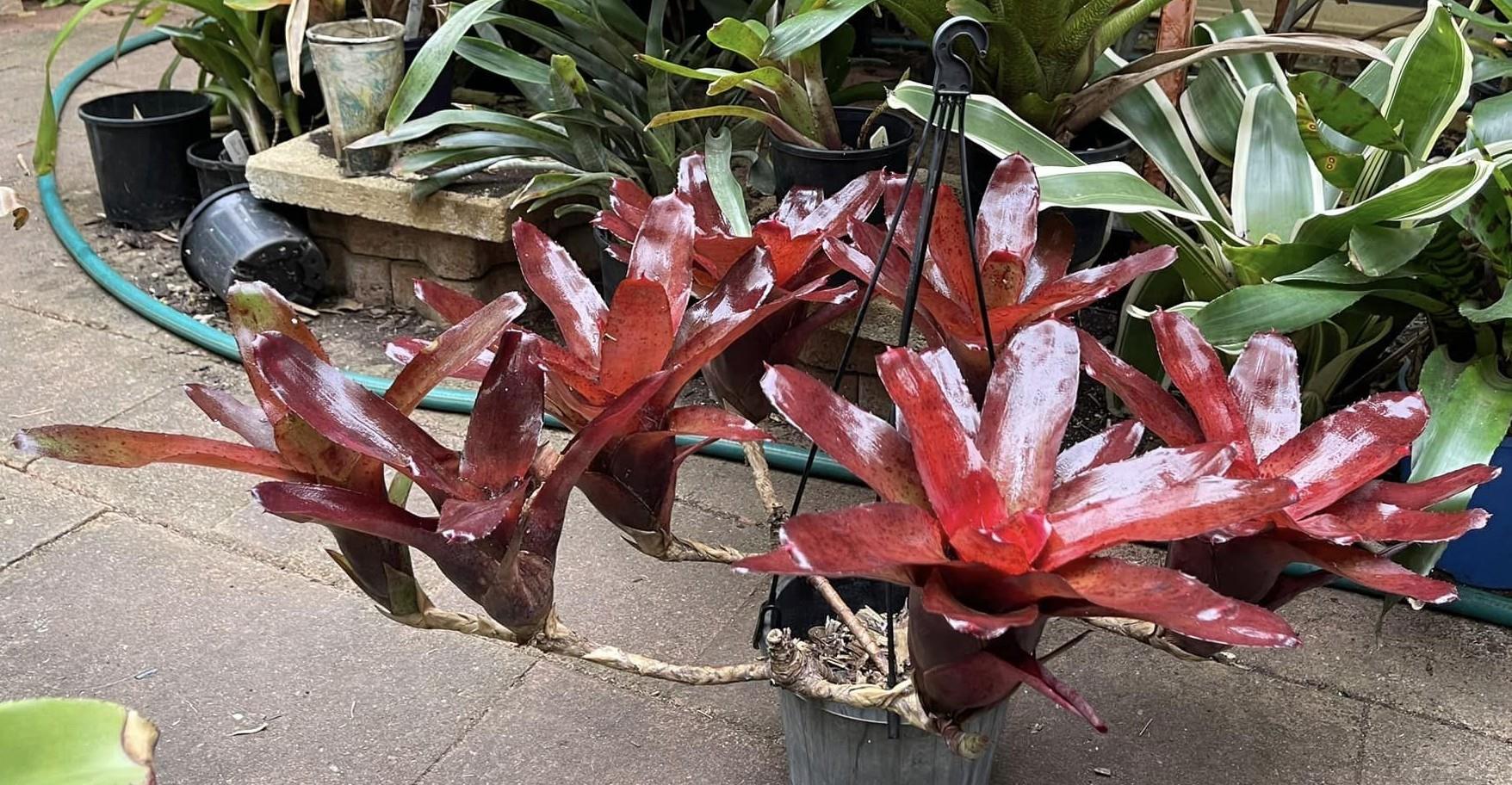
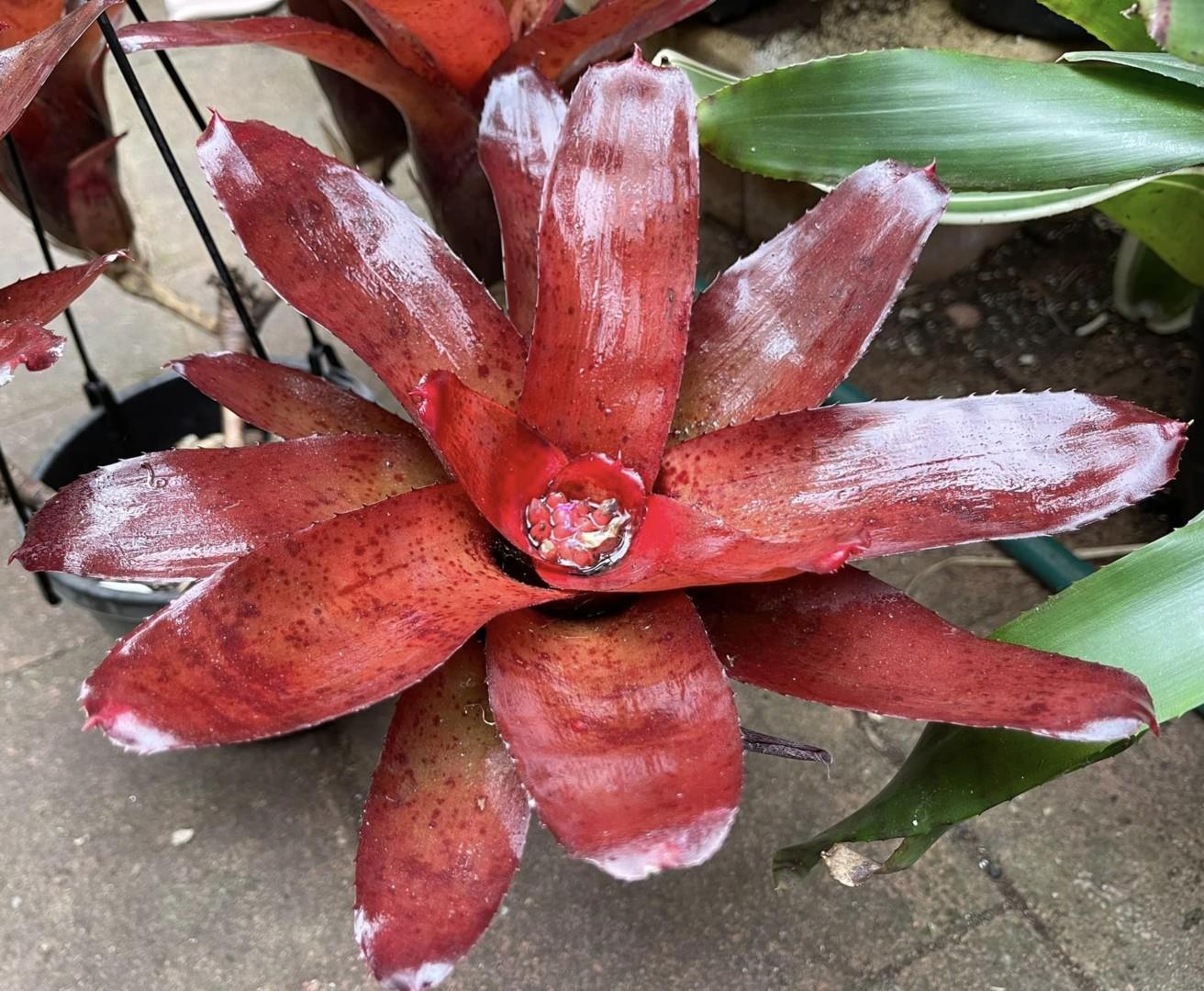
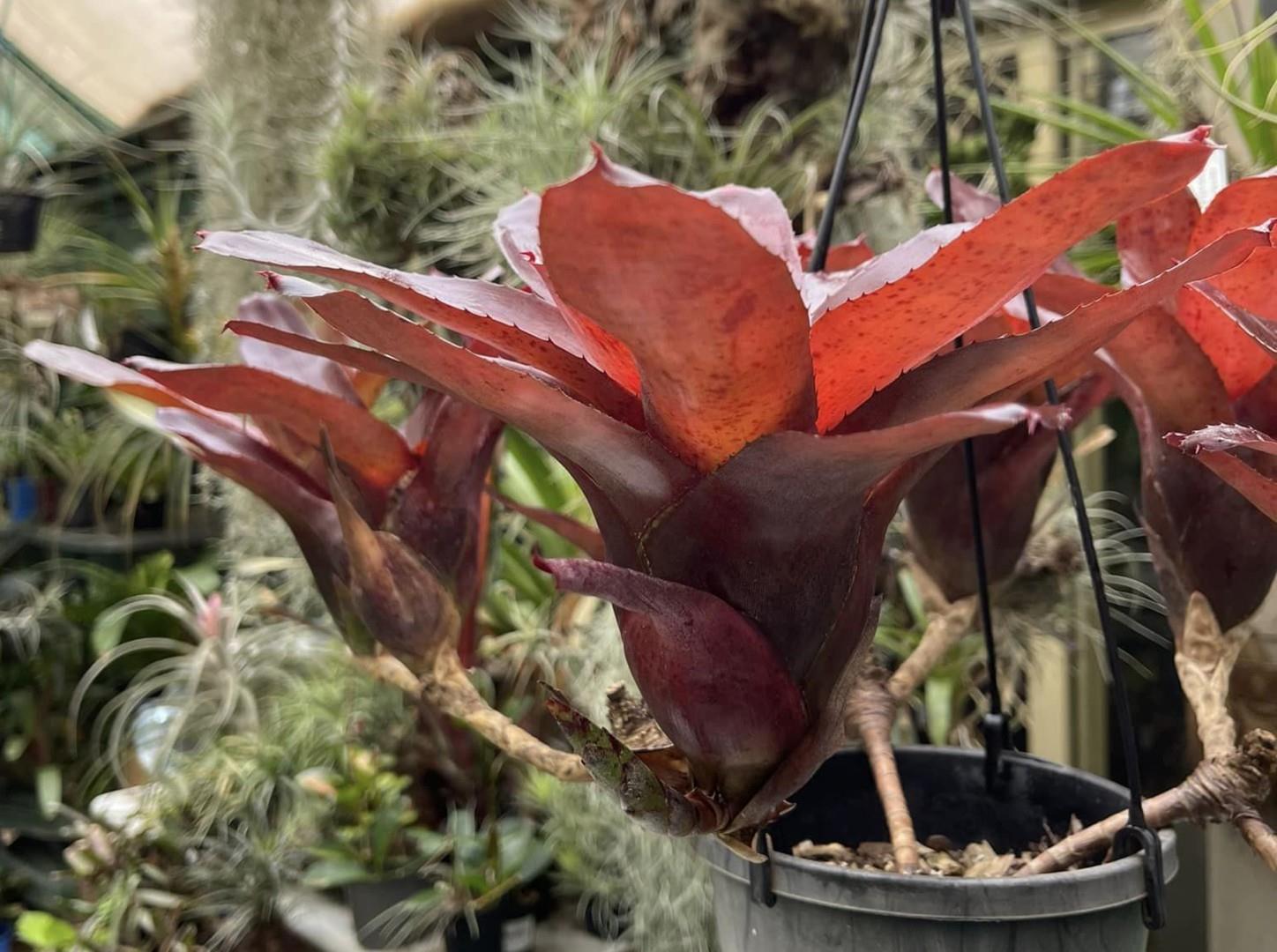

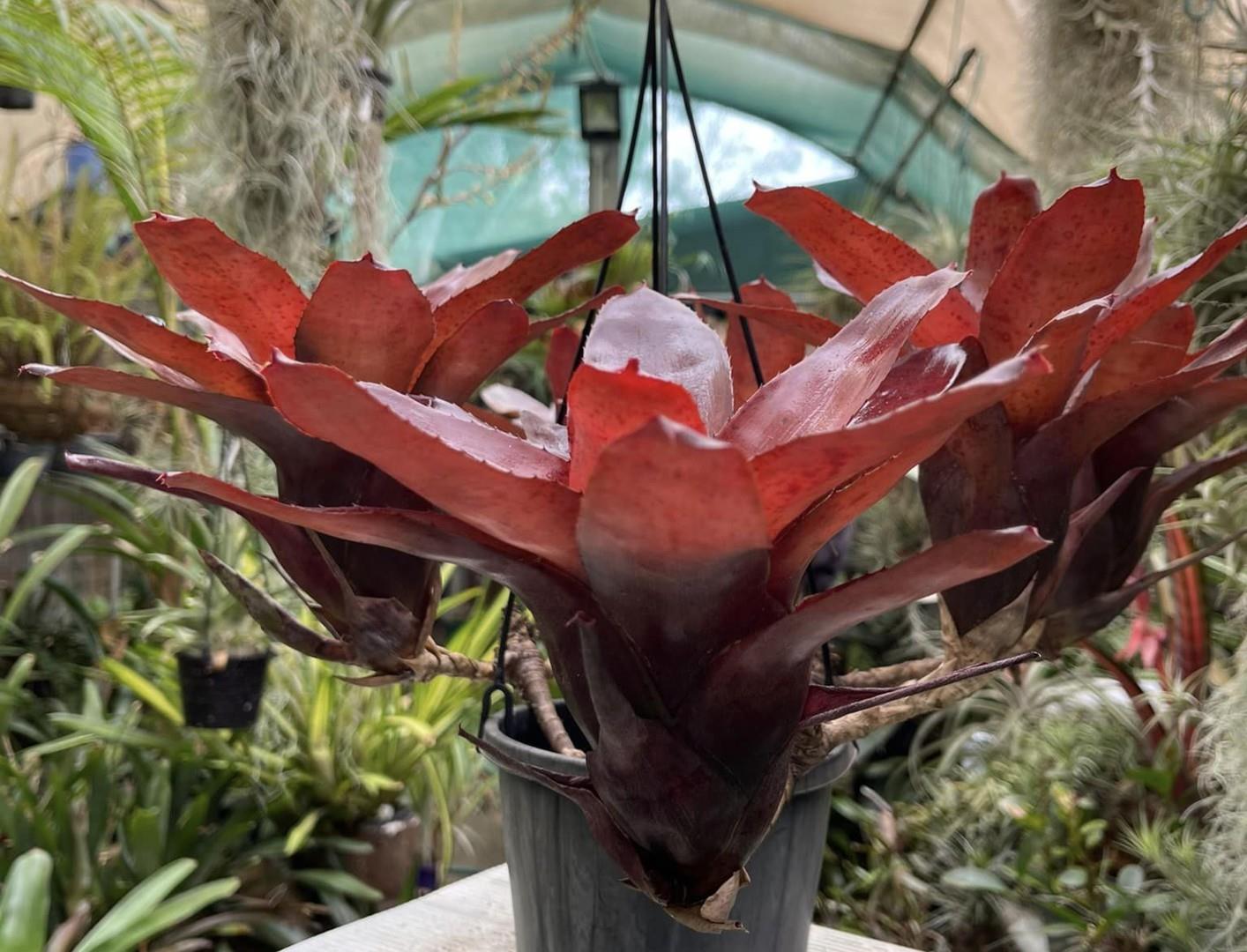
Desc from S&D
Leaves many in a slenderly funnelform rosette that is not constricted at apex, ca. 3 dm long, without spots;
Sheaths elliptic, green beneath;
Blades ligulate, broadly acute and apiculate, pungent, nearly 3 cm wide, minutely serrulate, glabrous, the outer green, the inner bright red.
Inflorescence deep in the rosette, few-flowered, ellipsoid, 2 cm in diameter;
Outer bracts broadly elliptic, apiculate, pale green, the lower serrulate.
Floral bracts elliptic, about equaling the sepals, entire;
Pedicels short, stout;
flowers 38 mm long.
Sepals very short-connate, asymmetric, acute;
Petals obtuse, blue;
Ovary ellipsoid.
Type. Typified by the original description and plate made from cultivated material. No specimens known to survive.
Distribution. Known only from the type which was presumably from Brazil.
TAB. 5502. Bot Mag April 1st. 1865
BILLBERGIA OLENS. Putrid-smelling Billbergia.
Nat. Ord. BROMELIACEAE - HEXANDRIA MONOGYNIA.
Gen. Char. Perigonii superi sexpartiti laciniae exteriores calycinae, aequales, ecarinatae, erectae, v. spiraliter convolutae, aristatae vel muticae, apice hinc oblique dilatatae, interiores petaloideae, exterioribus multo longiores, apice patentes vel erectae, intus basi squamosae v. bicristatae, rarius nudae. Stamina 6, epigyna ; filamenta filiformia, tria plerumque perigonii laciniis interioribus adnata ; antherae ovatae, dorso affixae, incumbentes vel suberectae. Ovarium inferum, triloculare. Ovula plurima e loculorum angulo centrali pendula, anatropa. Slylus filiformis ; stigmata 3, petaloidea, convoluta, v. linearia crispa. Bacca subglobosa, trilocularis. Stamina plura, nuda v. umbilicum filo gracili appendiculata. - Herbae Americanae tropicae, saepius super arborum truncis pseudoparasiticae, exscapae vel scapigerae, foliis ligulatis, linearibus vel ensiformibus, ut plurimum spinuloso-serratis, floribus spicatis-paniculatis vel racemoso-paniculatis, spathis floralibus, nunc nullis, nunc parvis v. amplis, coloratis. Endl.
BILLBERGIA olens: caule inclinato brevi cicatricato, foliis numerosis terminalibus erecto-patentibus subpedalibus ligulatis canaliculatis spinuloso-serratis balsi arcte imbricatis subventricosis apice mucronato-pungentibus, floralibus multo brevioribus erectis coccineis; spica oblonga sessili foliis floralibus multo breviore, bracteata, bracteis late ovatis acuminatis arcte imbricatis pallide viridibus rubro-tinctis, corollis paululum exsertis intense purpureis, spice subpatentibus, unguibus subbilamellatis.
This to us, previously unknown Bromeliaceous plant was received at Kew from Dr. Regel, of the Imperial Botamc Garden of St.Petersburg in 1856, and produced its rich purple, but very much concealed flowers and brilliantly-coloured floral leaves, in a warm stove the following year. It seems quite to accord in habit and in generic character with the Billbergia cruenta of Graham, in Bot. Mag. t. 2892, but is far more beautiful in the colour of the corollas, and still more of the floral leaves. It is to be regretted that no locality has been given with the plant but no doubt it is a native of tropical America, where the species of the family to which it belongs are great ornaments to the trunks of the forest trees, and where they are often intermixed with equally beautiful Orchidaceous plants. The present species has many points in common with Jacquin's Tillandsia ligulata (native of Martinique), of his Select. Stirp. American. p. .92. t. 62. still more with the coloured figure of the same plant in the Nuremberg edition of that work, entitled 'Amerikanische Gewachse nach Linneischer Ordnung', v. 2. t. 101, which plant Dr. Lindley refers to Plumier's and his genus Caraguata; and I should perhaps have referred it to that species, but that Jacquin says the flowers are white, whereas here they are a rich purple. It is the old and decaying flowers only which emit the odour that has suggested the specific name.
DESCR, Our plants grow in a fasciculated manner; the very short stem is thicker than one's finger, more or less scarred by the falling away of the lowest radical foliage. Leaves copious, imbricated, rather full green, glabrous, about a foot long, an inch or more wide, erecto-patent, ligulate, channelled, spinuloso-serrate at the margin, the apex sharply spinoso-acuminate, very pungent; the base sheathing and sub ventricose. Spike terminal, sessile, three inches long, amentiform, terminal, but so much shorter than the outer foliage, that it could not easily be seen but for the presence of the richly.coloured, erect floral leaves, longer, indeed, than the spike, but much shorter than the outer or cauline leaves. Bracts large, closely imbricated, greenish-white, tinged with reddish, very broad ovate, almost sheathing. Flowers mostly concealed by the bracts; the apex of the corolla only exserted. Calyx of three, sheathing, elongated sepals; petals with long claws, the spreading dark-purple limbs only exserted, the claws without scales, but with indistinct laminae. Stamens included, inserted near the middle of the claws. Filament very short; anther sagittate, pale-yellow. Ovary oblong; style filiform, as long as the claws of the petals; stigmas three, spirally twisted.
Dr. Read: We must understand that Walter Richter gave the name Vulkan (with a "k") to a hybrid that had no relationship to Neoregelia olens. Walter Richter's Vulkan was published in his Zimmerpflanzen von Heute und Morgen: Bromeliaceen, on page 279 (1962) where he listed N. x Vulkan (Richter)= N. concentrica x N. johannis.
Some time ago when I visited Marie Picard of New Orleans, I was shown a beautiful, compact cluster of plants of an unknown species of Neoregelia from Brazil (see fig. 14 and back cover). Marie, for want of a better name, called it 'Vulcan'. I suggested that since it was so distinctive and so interesting, it be published in the Journal as a cultivar, until I could identify it. Just before the 1977 New Orleans Bromeliad Conference I came upon Neoregelia (Billbergia) olens and determined that it was the correct name for Marie's plant. It was also at the conference, while visiting various private gardens, that I recognized how variable the species was, and that Marie's plant was a particularly good, miniature clone, suitable for cultivar recognition. Later, in Nat DeLeon's collection, I recognized Neoregelia olens again as his 696, a distinctly different clone of the same species, the botanical character of the sepals, petals, bracts, and total inflorescence being identical.
It is very true that the species is variable, but the variability has its limits within and between the different clones. That is, the kind or degree of effect the sun or climate has on a particular clone is peculiar to that clone (i.e. cultivar in this case).
Since there has not been a valid publication of Neoregelia olens cultivar 'Vulcan' the name should perhaps not be used. Moreover, since there is confusion with Richter's Neoregelia hybrid Vulkan we should straighten this out once and for all time by publishing a proper cultivar name for Marie Picard's plant. I propose that Marie's particularly fine, clearly-colored, compact clone henceforth be known as Neoregelia olens cv. 'Marie'. It should be understood that not all plants in cultivation known as 'Vulcan' are identical with Marie's plant; only those identical with or propagated from Marie's plant may carry the cultivar name 'Marie'.
Regarding the hybrid "Pepper", one parent, Neoregelia ampullacea var. tigrina 'Midget' is established as a cultivar even though not always correctly cited. The other parent "N. vulcan" does not exist as a botanical binomial. Neoregelia olens, as we have already indicated, is a very variable species with varying degrees of red spotting of the leaves, but the spotting of 'Pepper' more than likely came from N. ampullacea var. tigrina cultivar 'Midget', possibly intensified genetically by the spotty background of N. olens.
Mr. Luther: In my opinion, spots don't mean much. Many taxa in all three subfamilies may or may not be spotted, striped, or have discolor phases. Collectors, especially more horticulturally sophisticated ones, will, if given a chance, select the most colorful individuals in a population. The present-day cultivated N. olens are just better clones as far as color goes.
I have examined 696 and one other unnamed clone of N. olens. The unnamed clone and 696 appear to be conspecific with Vulcan meaning that they differ in characters that are of no real biological significance. They vary in the same way that D. Butcher and I vary. Vulcan, 696, and the third clone are all, as far as I am concerned, Neoregelia olens.
Everyone knows that Neos are very plastic. Some (N. cruenta) have been given sun and shade names. The shape, size, and color of the foliage may vary tremendously under different environments. With lots of experience one can guess how these vegetative characters will change under different regimes of light, water, and fertility. Different clones may vary in different ways. Usually, the flowers and associated organs remain more or less constant.
The inflorescences of Vulcan, 696, etc. are not a whole lot different from the one depicted and described in the Botanical Magazine for Billbergia olens (Hooker filius). They all belong to the same, apparently somewhat variable, species. Maybe Regel and Hooker didn't give the plant enough light. The dimensions of the foliage suggest this. More likely they just had the very rare, unspotted cultivar which seems to have vanished from horticulture. Maybe they thought the spots unattractive or abnormal and deleted this information from the text. Perhaps they thought it didn't matter as this plant was otherwise adequately distinct from all other "Billbergias" known at this time (1865).
NOTES:
Jeffrey Kent told the editor that 696 is a collector's number given by Alvim Seidel (but Seidel does not claim it).